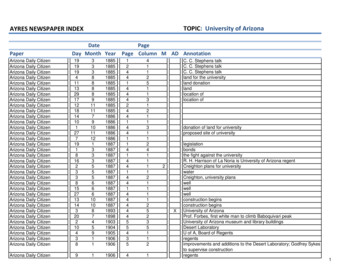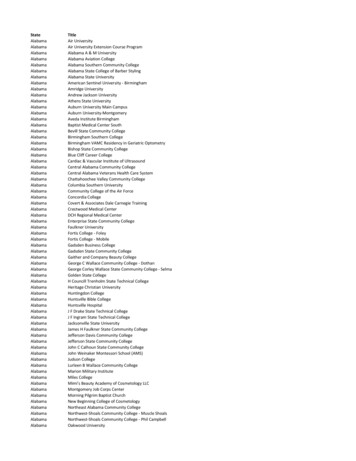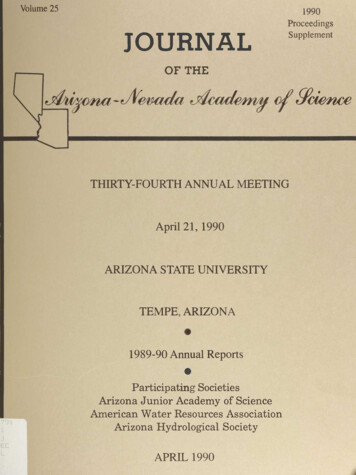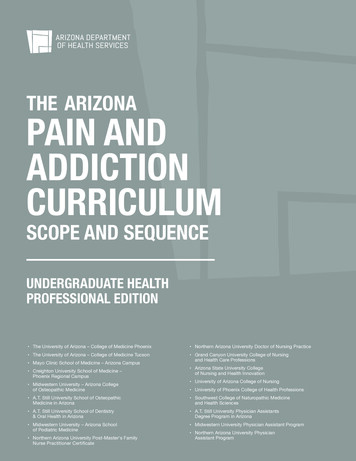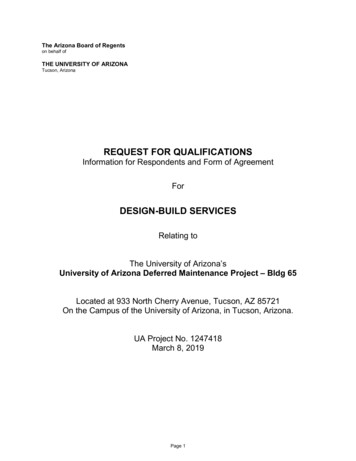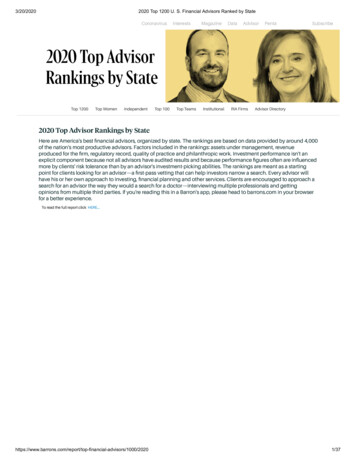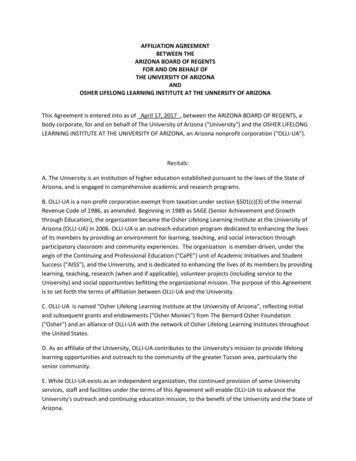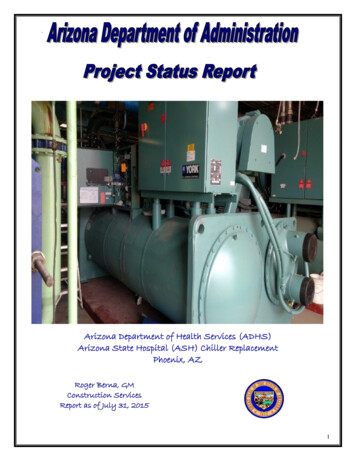
Transcription
“The Go-To Guide”A Guide for Resource ParentsInformation You Need To Know But not all of it!Arizona Department of Child Safety
IntroductionOriginally prepared by the Arizona PS-MAPP Training Team and revised by the TrainingDevelopment and Delivery Accountability (TDDA) program within the Office of Licensing andRegulation (OLR) in March of 2016.This Guide provides basic information about the child welfare system in Arizona to help youunderstand how children come into care, why they are there, and the rules and policies that havebeen created to protect children in out-of-home care. It has information about the roles andresponsibilities of the people connected to the child welfare and court systems who may work witha child, his or her family, and your family.The information in this Guide is primarily focused on the needs of Department of Child Safety(DCS). The terms resource parent, foster parent, and caregiver are used throughout this documentand all are in reference to the parent caring for the foster child. Each DCS resource family shouldhave a copy of the following resource handbooks and handouts. Title 21, Chapter 6, Articles 1-4, the Foster Home Licensing RulesTitle 21 Chapter 6 Chapter 8, the Life-Safety RulesDCS Discipline Policy Resource GuideCMDP (Comprehensive Medical and Dental Program) Member HandbookConfidentiality, Guidelines for Foster ParentsOut of Home Provider AcknowledgementFamily Foster Home and Fees Schedule (DCS)Life-Safety Inspection Worksheet (R21-6-101.44) this replaces the guide, Life-SafetyInspections, The Rules in Plain EnglishThe ADCS Caregiver Procedures for Reasonable and Prudent Parenting (RPPS)If you do not have copies of this information, please contact your licensing agency for assistancein obtaining these documents. Please note, the above references and resources are subject tochange. Please contact your licensing agency to assure you have the most up-dated information.Resource Parents with the Department of Economic Security (DES)/Division of DevelopmentalDisabilities (DDD) or Department of Health Services (DHS)/Regional Behavioral Health Authority(RBHA)/Home Care Treatment Care for Home Care Clients (HCTC) will need some or all of thesereference guides in addition to the information specific to either program services.Disclaimer: This information is subject to change based upon the availability of new interpretations,new standards, new policies, federal and state laws, new eligibility requirements or services offeredand other developments in the field. Please refer to the DCS, CMDP or other referenced web sitesfor the most current available information. The material provided on this document is designed foreducational and information purposes only. This information is not inclusive of all terms, provisions,providers, services and/or support necessary to care for a foster child.The Go-To-Guide (as of May 9th, 2016)iCSO-1171A (ACY-1239A)
Table of ContentsINTRODUCTIONIDEPARTMENT OF CHILD SAFETY7DCS Guiding Principles .7Programs & Services8Arizona Child Abuse Hotline Intake Center .8Reporting Suspected Child Abuse .8Mandated Reporters of Suspected Child Abuse .9Family-Centered Practice .12Team Decision Making (TDM) .12Introductory Meeting (Ice Breaker) .13Permanency Planning13Determining a Permanency Goal .13The Family Centered Case Plan .13Family Reunification Services .15Concurrent Permanency Planning .15Adoption .15Guardianship .16Difference between Adoption and Guardianship .17Foster Parent Adoptions .17Independent Living Services Program .17Department of Child Safety (DCS) Policy and Procedures Manual .18PLACEMENTS19Children In Out-Of-Home Care .19How Children Come Into Care/Family Reunification .19Selection of an Out-of-Home Care Provider .19Kinship Foster Care .20Medically Complex/Fragile Placements .20Interstate Compact on the Placement of Children (ICPC) .21Placement Packet .22Normal Expectations in the First Month of Placement .24Child Safety Specialist's Visits with the Child .25Foster Home Transition .27Capacity Requirements .27RESOURCE PARENTING29Foster Parent Rights .29Confidentiality .29Discipline .31Members of the Child Welfare Service Team .32The Go-To-Guide (as of May 9th, 2016)iiCSO-1171A (ACY-1239A)
Communication and Documentation with Members of the “The System” .33Contact List.33Advice or Assistance.34Complaint Management .34Unusual Incident Notification .34Document, Document, Document! .35Emergency Contact Information .36Run Away Children .37Supervision/ Shot- Term Caregiver .37Child Care by a DES Child Care Administration (CCA) .38Respite .39Reasonable and Prudent Parenting Standard (RPPS) .40Unsupervised Time.40Transportation .40Vehicle Requirements .41Car Seats/Child Restraint Systems .41Driver's License for a Youth in Care .42Travel – Out of Town .43Travel – Out of Country .43Safe Sleeping for Baby.44Honoring the Child’s Culture .45Religious Practices .45Participation in Sports and Activities .45Smoking Policy .45Haircuts .45Tattoos and Body Piercing .46Pets for Children in Care .46Google It! .46SHARED PARENTING46Introductory (Ice Breaker) Meeting Participation .46Visitation Plan .47Supervised Visits .48Visitation Facilitator .48HEALTH CARE48Health Information Portability and Accountability Act (HIPAA) .48Authorization for Treatment .49Pharmacist Support .50Comprehensive Medical and Dental Program (CMDP) Prescribed Medications .50Regional Behavioral Health Authority (RBHA) Prescribed Medications .50Medical and Dental Care Comprehensive Medical and Dental Program (CMDP)50CMDP Identification (ID) Card .51Choosing a Primary Care Provider/Medical Home.51An Early and Periodic, Screening and Diagnostic Treatment Examination (EPSDT) .52The Go-To-Guide (as of May 9th, 2016)iiiCSO-1171A (ACY-1239A)
Information to be Provided to the Primary Care Provider .53Immunizations.53Dental Care.53Vision Care .54Tobacco Cessation.54Emergency Medical Care.54Medically Necessary Incontinent Briefs (diapers or pull-ups).55Child Sexual Development Education and Family Planning .55Deductibles and Signing for CMDP Services.55Behavioral Health Care Regional Behavioral Health Authorities (RBHA)56The Regional Contractors .56Behavioral Health Services .56Regional Behavioral Health Authority (RBHA) Time Frames .58The Child and Family Team .58Arizona’s Child And Adolescent Service Intensity Instrument (CASII) .59The Arizona Vision or the 12 Principles .60FINANCIAL SUPPORTS62Family Foster Home Care Payment Classifications .62Foster Care Reimbursement-Payment Procedures.62Clothing Allowance and Personal Allowance .63Special Clothing Allowances .63Books/Education Allowance.63Supplemental Extra School Tuition and Fees .63Passport Allowance .63Special Needs Allowance.64High School Graduation Allowance .64Diaper Allowance-Special .64Medically Necessary Diapers and Briefs .64Child Care .64Camp – Day and Overnight .64Adoption Subsidy .64Guardianship Subsidy .65Income Tax Status .65EDUCATION65Arizona Early Intervention Program (AzEIP).65School Enrollment .66School Breakfasts and Lunches .66School Enrollment- Special Considerations .67The Go-To-Guide (as of May 9th, 2016)ivCSO-1171A (ACY-1239A)
Educational Advocate .67Individuals with Disabilities Education Act (IDEA).67Individualized Education Plan (IEP) .68Head Start and Early Head Start.68Appointments Not During School .69LEGAL PROCESS69Who Is Involved: Understanding the Roles and Responsibilities? .69Arizona Dependecy Process .71Juvenile Court Hearing Types .71Foster Care Review Board (FCRB) .72Resource Parents Notification of Juvenile Court Hearings and Foster Care Review Board Hearings .73Juvenile Court Hearings Open To The Public .73Termination of Parental Rights (TPR) .73Indian Child Welfare Act (ICWA): .75Delinquency .75Dually Adjudicated Youth .76RULES, REGULATIONS & REQUIREMENTS76Office of Licensing and Regulation (OLR) .76Title 21, Chapter 6, Articles 1-4 (Foster Home Licensing Requirements) – Become an Expert .76Title 21, Chapter 8 (Life and Safety Inspection Rules) - Learn These Requirements.76Life-Safety Inspections .77Emergency Evacuation Plan .77Disaster Plan.77Notification of Major Events .77Foster Parent License – You and Your Residence are Licensed .78Foster Parent License-You Own Your License .78Quick Connect .78Foster Parent License Renewal .78Foster Parent License Renewal Training .79DCS Investigation of the Resource Family .79Licensing Concerns in a Foster Home or Family .79Kinship Foster Care Waivers of Licensing Rules .80SUPPORTS81Arizona Association for Foster and Adoptive Parents (AZAFAP) .81DCS Liaison for Resource Parents .81DCS "Warm Line' for Resource Parents .81DCS Liaison to Tribes .81Ombudsman’s Office, State of Arizona .81Provider Indemnity Program (PIP) - Risk Management Insurance .81Arizona Friends of Foster Care Foundation.82The DES/Division of Developmental Disabilities (DDD) .83DES/DDD Child Developmental Homes (CDH) .83The Go-To-Guide (as of May 9th, 2016)vCSO-1171A (ACY-1239A)
Women, Infant and Children (WIC) .83Boy’s and Girl’s Club Membership .83Raising Special Kids .84MIKID (Mentally Ill Kids in Distress) .84NAMI Arizona (National Alliance on Mental Illness) .84The Q Line .84PFLAG (Parents, Families and Friends of Lesbians and Gays) .85Trans Youth Family Allies (TYFA) .85Community Resources .85ACRONYMS86ADA DISCLOSUREGThe Go-To-Guide (as of May 9th, 2016)viCSO-1171A (ACY-1239A)
Department of Child SafetyThe Department of Child Safety (DCS) was created on May 29, 2014 by statute as a Departmentseparate from the Department of Economic Security.DCS Guiding Principles Children need safe, strong families to succeed in life.Child safety, permanency and well-being are our top priorities.Families have the primary responsibility for raising their children.Families should be treated with respect, valuing their strengths, their culture and theirinvolvement in decisions that affect them and their children.Prevention is paramount, and all actions should focus on improving family situations.Children belong with families-their own, when safe to do so and when it is not, with asafe, permanent family as soon as possible.The community must be a partner in supporting and strengthening both birth familiesand resource familiesThe primary objective of DCS is to keep children safe within their own families. DCS workscooperatively with parents to make that happen. It seeks to help families by strengthening the abilityof parents, guardians or custodians to provide quality care for their children. The program strivesto balance the legal rights of parents and the needs and rights of children to live in a physically andemotionally healthful situation. DCS is the state child welfare services agency responsible for theprovision of child safety services; family foster care and kinship foster care services; services topromote the safety, permanence, and well-being of children; adoption and support services; andhealth care services for children in out-of-home care.The Comprehensive Medical and Dental Program (CMDP) is the health plan for children in fostercare. The Child Welfare Administration manages Child Safety Services in Arizona’s fifteencounties. The fifteen counties are divided into five regions. The Central, Southwest, and PimaRegions encompass the state’s urban areas. The Northern and Southeast Regions are rural. Eachregion has a Program Manager (PM); Southwest, Central and Pima Regions have a DeputyProgram Manager (DPM). All regions have Assistant Program Managers (APM) and DCSSupervisors who oversee the daily work of the Child Safety Specialists.The Go-To-Guide (as of March 15, 2016)CSO-1171A (ACY-1239A)7
The counties within each region are:Southwest RegionWestern Maricopa, Yuma and La PazCentral RegionEastern Maricopa and PinalPima RegionPimaNorthern RegionApache, Coconino, Mohave, Navajo and YavapaiSoutheast RegionCochise, Gila, Graham, Greenlee and Santa CruzEach region provides: Investigation of reports of abuse and neglect,Case management,Permanency planning,In-home services (prevention and support)Out-of-home services, (foster care and adoptions)Independent living and young adult programsContracted foster and adoptive home recruitment, study, training and supervision.Programs & ServicesArizona Child Abuse Hotline Intake CenterThe Intake Center receives all reports of suspected child abuse and neglect statewide. The IntakeCenter is part of the Department of Child Safety (DCS). Reports should be called in to the IntakeCenter for suspected child abuse and significant incidents that occur in a resource family home, orany other location. The hotline can be also be used for any communication involving emergenciesand/or unusual inci
Southwest Region Western Maricopa, Yuma and La Paz Central Region Eastern Maricopa and Pinal Pima Region Pima Northern Region Apache, Coconino, Mohave, Navajo and Yavapai Southeast Region Cochise, Gila, Graham, Greenlee and Santa Cruz Each region provides: Investigation of reports of abuse and neglect, Case management,


